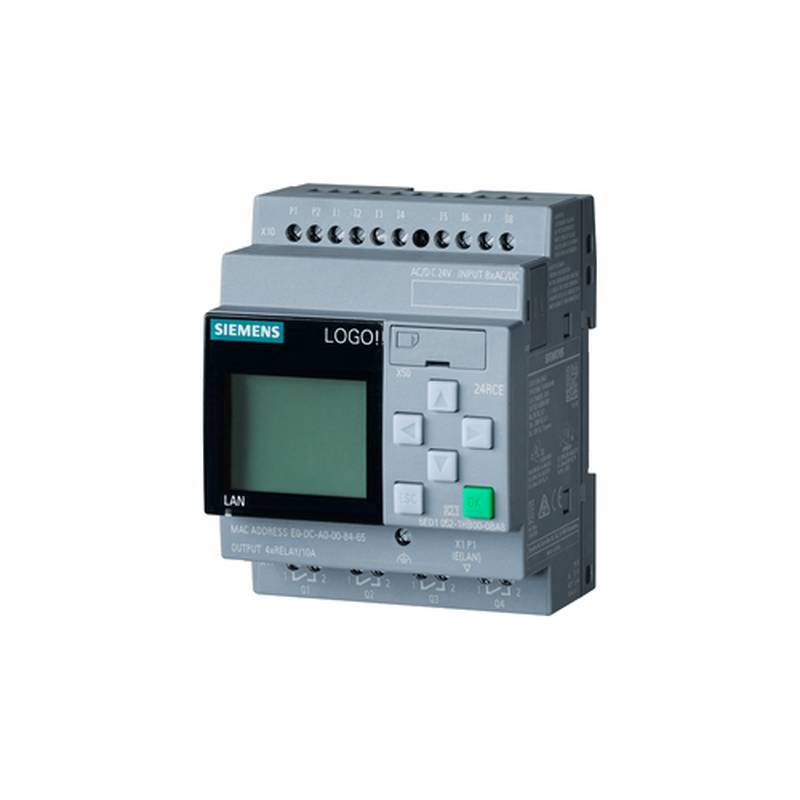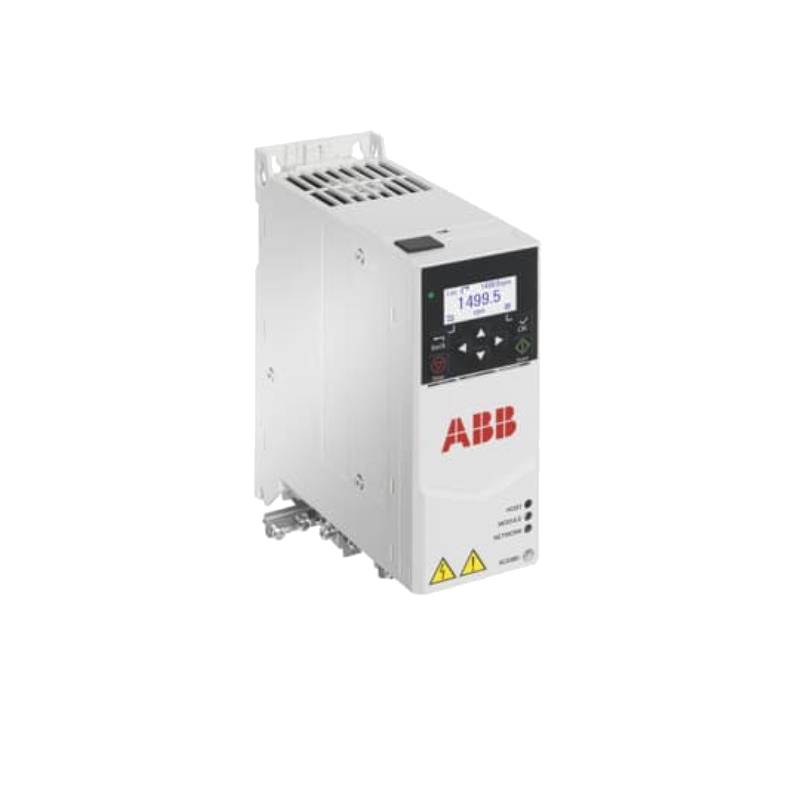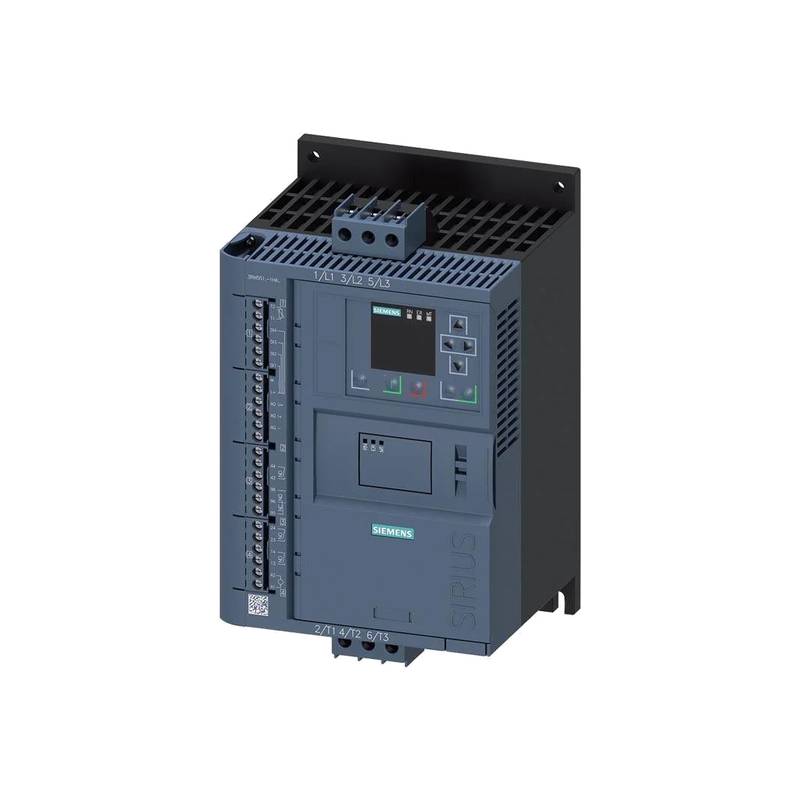
The INVT GD200A-200G/220P-4, a high-performance vector control Variable Frequency Drive (VFD), stands out in the industrial automation landscape for its robust capabilities and precise motor control. This VFD delivers exceptional performance across a wide range of applications, boasting features such as advanced sensorless vector control, multiple motor control modes, and a comprehensive suite of protection functions. With a rated power of 220kW (or 300HP), an input voltage of 3-phase 400V/480V, and an output current of 200A, the GD200A series is engineered for demanding industrial environments. Its intuitive interface, flexible communication options, and compact design further enhance its appeal to system integrators and end-users seeking reliable and efficient motor control solutions.
Product Specifications
| Parameter | Value |
| :--------------------- | :------------------------------------------ |
| Model Number | INVT GD200A-200G/220P-4 |
| Rated Power | 220 kW / 300 HP |
| Input Voltage | 3-Phase, 400V/480V AC |
| Output Current | 200 A |
| Control Method | Sensorless Vector Control, V/f Control |
| Frequency Output | 0-3000 Hz |
| Overload Capacity | 150% rated current for 60s |
| Protection Features | Overvoltage,Undervoltage, Overcurrent, etc. |
| Communication Options | RS485 (Modbus), Optional fieldbuses |
| Operating Temperature | -10°C to +40°C (derating above 40°C) |
Core Features & Market Positioning
The INVT GD200A-200G/220P-4 distinguishes itself through its advanced sensorless vector control algorithm, providing superior torque response and precise speed regulation even without encoder feedback. This technology, coupled with its ability to support multiple motor types (induction and permanent magnet synchronous motors), positions it as a versatile solution for applications demanding high accuracy and efficiency. The VFD's robust overload capability of 150% for 60 seconds ensures reliable operation under transient heavy loads, a critical factor in many industrial processes. Furthermore, its integrated braking unit and optional external braking resistors offer flexible braking solutions for applications requiring rapid deceleration. INVT's commitment to quality and innovation is evident, making the GD200A series a competitive choice against other premium VFD manufacturers.
Key Application Scenarios
This high-performance VFD is ideally suited for a broad spectrum of demanding industrial applications. Its precise speed and torque control make it an excellent choice for pump and fan applications, where variable speed operation significantly improves energy efficiency and reduces operational costs. In conveyor systems and material handling equipment, the GD200A-200G/220P-4 ensures smooth starting, stopping, and speed adjustments, enhancing throughput and reducing wear on machinery. The drive's robust performance also lends itself to extruders, plastic machinery, and textile equipment, where consistent speed and torque are paramount for product quality. For applications requiring dynamic response, such as machine tools and crane applications, its advanced vector control capabilities provide the necessary precision and agility.
Practical System Integration Guidance
Integrating the INVT GD200A-200G/220P-4 into existing industrial systems is facilitated by its user-friendly design and flexible connectivity. Ensure proper power wiring adhering to local electrical codes, connecting the 3-phase input to the L1, L2, L3 terminals and the motor to the T1, T2, T3 terminals. For optimal performance and safety, utilize shielded motor cables and ensure proper grounding of both the VFD and the motor. Commissioning typically involves parameter setup via the keypad or communication interface. Key parameters to configure include motor data (rated power, voltage, current, frequency), control mode (sensorless vector or V/f), acceleration/deceleration times, and speed references. The integrated RS485 port supports the Modbus RTU protocol, allowing seamless integration with PLCs and SCADA systems for remote monitoring and control.
Operation and Risk Mitigation
Operating the INVT GD200A-200G/220P-4 requires adherence to safety protocols to mitigate potential risks. Always disconnect power before performing any wiring or maintenance. The VFD features comprehensive protection functions, including overvoltage, undervoltage, overcurrent, overload, short circuit, and overheating protection, which will trigger fault codes to indicate issues. Common troubleshooting involves checking parameter settings, verifying motor connections, and ensuring adequate ventilation. For instance, an "Overcurrent" fault (e.g., Fault Code 01) might indicate a rapid acceleration request exceeding the drive's capacity or a motor short circuit, requiring a review of acceleration ramps and motor insulation. Understanding these fault codes and their probable causes is crucial for rapid issue resolution and minimizing downtime.
Scalability & Long-Term Value
The INVT GD200A-200G/220P-4 offers significant scalability and long-term value for industrial operations. Its compatibility with various fieldbus communication modules (e.g., Profibus, DeviceNet) allows for seamless integration into diverse automation architectures and supports future upgrades to networked control systems. The drive's ability to control both induction and permanent magnet motors provides flexibility, accommodating evolving motor technologies and enabling energy efficiency improvements over the lifespan of the equipment. For businesses embracing Industry 4.0 initiatives, the GD200A's communication capabilities facilitate data acquisition for performance monitoring, predictive maintenance, and integration into IIoT platforms, enhancing overall operational intelligence and return on investment.
Frequently Asked Questions
Q1: What is the maximum output frequency of the INVT GD200A-200G/220P-4?
The GD200A-200G/220P-4 supports an impressive output frequency range, typically extending up to 3000 Hz. This broad frequency capability ensures suitability for high-speed motor applications commonly found in specialized industrial machinery.
This wide range allows for precise control over a vast spectrum of motor speeds, crucial for optimizing process efficiency and product quality in demanding sectors. It means the drive can cater to applications requiring both slow, precise movements and extremely rapid operational speeds.
The ability to achieve such high frequencies is a testament to the drive's advanced control algorithms and robust power electronics design. It ensures that even at maximum output, the drive maintains stability and delivers accurate torque control.
Q2: How does sensorless vector control benefit my application with this VFD?
Sensorless vector control provides precise motor speed and torque regulation without the need for an external encoder on the motor shaft. This simplifies installation and reduces overall system cost by eliminating the encoder and its associated wiring.
This advanced control method ensures excellent dynamic performance, allowing the VFD to respond quickly to changes in load or speed commands. It's ideal for applications where rapid acceleration/deceleration or stable operation under varying torque demands is critical.
By accurately estimating motor flux and rotor position, sensorless vector control achieves performance comparable to closed-loop vector control in many scenarios. This makes it a highly versatile and cost-effective solution for a wide array of industrial motor control needs.
Q3: Can the INVT GD200A-200G/220P-4 control permanent magnet synchronous motors (PMSM)?
Yes, the INVT GD200A-200G/220P-4 is designed to effectively control both standard induction motors and permanent magnet synchronous motors (PMSM). This dual motor compatibility enhances its application flexibility and future-proofing.
Utilizing PMSMs with this VFD can lead to significant energy savings and improved performance due to their higher efficiency and power density compared to induction motors. This is particularly beneficial in applications prioritizing energy optimization.
The drive's advanced control algorithms are optimized to harness the unique characteristics of PMSMs, ensuring precise speed and torque output. This makes it a powerful solution for modern, high-efficiency industrial machinery designs.
Q4: What are the typical overload capabilities of this VFD?
The INVT GD200A-200G/220P-4 offers robust overload handling, typically rated for 150% of its nominal current for up to 60 seconds. This capability ensures that the drive can manage temporary torque surges without tripping.
This feature is critical for applications that experience transient load increases, such as during the startup of heavy machinery or during specific process phases. It prevents nuisance tripping and ensures continuous operation under demanding conditions.
The drive's ability to withstand such overloads without damage is due to its robust thermal management system and high-quality power components. It provides a reliable buffer for peak load requirements.
Q5: How can I integrate this VFD with my existing PLC system?
Integration with PLC systems is primarily achieved through the VFD's built-in RS485 communication port, which supports the Modbus RTU protocol. This allows for seamless data exchange and remote control.
For more complex automation architectures, INVT offers optional communication modules for other major fieldbuses like Profibus, DeviceNet, and EtherNet/IP, ensuring compatibility with diverse PLC platforms. Configuration of communication parameters is straightforward within the VFD's menu.
Setting up communication involves configuring the VFD's address and baud rate to match your PLC's settings, and then mapping control words, status words, and data registers according to the Modbus protocol. This enables comprehensive monitoring and control of the drive.
Q6: What safety features are included in the INVT GD200A-200G/220P-4?
This VFD incorporates a comprehensive suite of protection features designed to safeguard both the drive and the connected motor. These include protections against overvoltage, undervoltage, overcurrent, overload, short circuit, and motor overheating.
It also typically includes features like stall prevention during operation and protection against rapid acceleration/deceleration issues, which can lead to mechanical stress or drive faults. These built-in protections minimize the risk of damage and ensure operational reliability.
For enhanced safety, the drive often supports safe torque off (STO) functionality, allowing for a reliable and rapid shutdown of motor power without the need to physically disconnect the supply. This is a critical feature for compliance with machinery safety standards.
Q7: What is the operating temperature range for this VFD?
The INVT GD200A-200G/220P-4 is designed to operate reliably within a standard industrial temperature range, typically from -10°C to +40°C ambient temperature. It's important to consider derating if operating at higher temperatures.
Exceeding the specified ambient temperature without proper derating can lead to reduced performance, component stress, and potential drive failure. Adequate ventilation and cooling are crucial, especially in enclosed control cabinets.
For installations in extreme environments, consult the product manual for specific derating curves and recommendations. Proper environmental control ensures the longevity and consistent performance of the VFD.
Q8: Does this VFD require a braking resistor?
The necessity of a braking resistor depends on the application's regenerative load characteristics. For applications with significant overhauling loads (e.g., cranes, downhill conveyors), an external braking resistor might be required to dissipate excess energy.
The GD200A series often includes an integrated braking unit up to a certain power rating. For higher braking energy requirements, an external resistor can be connected to dedicated terminals, allowing the VFD to safely manage braking torque and prevent overvoltage faults.
Proper sizing of the braking resistor is essential to prevent overheating and ensure effective braking. The VFD's parameters allow for configuration of braking control strategies and monitoring of the braking resistor's status.
Q9: What is the power factor correction of this VFD?
While VFDs inherently provide some power factor improvement, the INVT GD200A-200G/220P-4 typically achieves a high power factor at the input terminals, especially when operating under load. This reduces reactive power demand and improves overall system efficiency.
The drive's design and control strategies contribute to minimizing harmonic distortion and maximizing the power factor, which can help in avoiding utility penalties for low power factor. It generally operates with a power factor close to unity.
For applications requiring even tighter power factor control or compliance with specific grid codes, external power factor correction devices or specialized input filters might be considered, although the VFD itself offers significant improvements.
Q10: What kind of motor protection is built into the INVT GD200A-200G/220P-4?
The VFD incorporates comprehensive electronic motor protection features to safeguard the motor from various fault conditions. This includes thermal overload protection based on motor current and thermal modeling.
Additional built-in protections typically cover phase loss, short circuits, ground faults, and over/under-voltage conditions, preventing damage to the motor and the drive itself. These protections are configurable to match specific motor requirements.
The drive also offers features like motor anti-stall protection during operation, which helps prevent the motor from stalling under heavy loads. This ensures continuous operation and prevents potential damage.

























